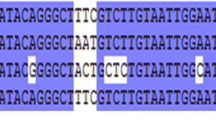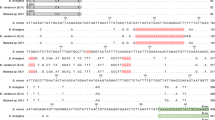Abstract
The application of high-resolution melting (HRM) analysis in the differentiation between Theileria equi and Babesia caballi was evaluated using control samples from the United States Department of Agriculture and field samples collected from horses in Sudan and China. A region of the 18S rRNA gene, with four known nucleotide differences between the two parasites, was selected for primer design. HRM analysis successfully allowed the detection and differentiation of T. equi and B. caballi without the necessity of performing time-consuming and expensive post-PCR procedures such as sequencing or restriction digestion. Our results suggest that HRM could be an ideal method for rapid genotyping, which is required to determine a drug of choice or to administer an appropriate vaccine during an outbreak.



Similar content being viewed by others
References
Adaszek Ł, Winiarczyk S (2010) Application of the SYBR Green real-time HRM PCR technique in the differentiation of the Babesia canis canis protozoa isolated in the areas of eastern Poland. Parasitol Res 106:1253–1256. doi:10.1007/s00436-010-1784-3
Bakheit MA, Seitzer U, Mbati PA, Ahmed JS (2007) Serological diagnostic tools for the major tick-borne protozoan diseases of livestock. Parassitologia 49(Suppl 1):53–62
Bhoora R, Franssen L, Oosthuizen MC et al (2009) Sequence heterogeneity in the 18S rRNA gene within Theileria equi and Babesia caballi from horses in South Africa. Vet Parasitol 159:112–120. doi:10.1016/j.vetpar.2008.10.004
Brüning A (1996) Equine piroplasmosis an update on diagnosis, treatment and prevention. Br Vet J 152:139–151. doi:10.1016/S0007-1935(96)80070-4
Dobrowolski SF, Ellingson C, Coyne T et al (2007) Mutations in the phenylalanine hydroxylase gene identified in 95 patients with phenylketonuria using novel systems of mutation scanning and specific genotyping based upon thermal melt profiles. Mol Genet Metab 91:218–227. doi:10.1016/j.ymgme.2007.03.010
Friedhoff KT, Tenter AM, Müller I (1990) Haemoparasites of equines: impact on international trade of horses. Rev Sci Tech Int Off Epizoot 9:1187–1194
Krypuy M, Newnham GM, Thomas DM et al (2006) High resolution melting analysis for the rapid and sensitive detection of mutations in clinical samples: KRAS codon 12 and 13 mutations in non-small cell lung cancer. BMC Cancer 6:295. doi:10.1186/1471-2407-6-295
Kuttler KL (1988) World-wide impact of babesiosis. In: Ristic M (ed) Babesiosis of domestic animal and man. CRC, Boca Raton, pp 1–22
Liew M, Pryor R, Palais R et al (2004) Genotyping of single-nucleotide polymorphisms by high-resolution melting of small amplicons. Clin Chem 50:1156–1164. doi:10.1373/clinchem.2004.032136
Margraf RL, Mao R, Highsmith WE et al (2006) Mutation scanning of the RET protooncogene using high-resolution melting analysis. Clin Chem 52:138–141. doi:10.1373/clinchem.2005.052951
Mehlhorn H, Schein E (1998) Redescription of Babesia equi Laveran, 1901 as Theileria equi Mehlhorn, Schein 1998. Parasitol Res 84:467–475
Nagore D, Garcı'a-Sanmartı'n J, Garcı'a-Pérez AL et al (2004) Detection and identification of equine Theileria and Babesia species by reverse line blotting: epidemiological survey and phylogenetic analysis. Vet Parasitol 123:41–54. doi:10.1016/j.vetpar.2004.04.010
Reed GH, Wittwer CT (2004) Sensitivity and specificity of single-nucleotide polymorphism scanning by high-resolution melting analysis. Clin Chem 50:1748–1754. doi:10.1373/clinchem.2003.029751
Reed GH, Kent JO, Wittwer CT (2007) High-resolution DNA melting analysis for simple and efficient molecular diagnostics. Pharmacogenomics 8:597–608. doi:10.2217/14622416.8.6.597
Rhalem A, Sahibi H, Lasri S et al (2001) Validation of a competitive enzyme-linked immunosorbent assay for diagnosing Babesia equi infections of Moroccan origin and its use in determining the seroprevalence of B. equi in Morocco. J Vet Diagn Invest 13:249–251. doi:10.1177/104063870101300311
Salim B, Bakheit MA, Kamau J et al (2010) Nucleotide sequence heterogeneity in the small subunit ribosomal RNA gene within Theileria equi from horses in Sudan. Parasitol Res 106:493–498. doi:10.1007/s00436-009-1691-7
Salim B, Bakheit MA, Kamau J, Sugimoto C (2013) Current status of equine piroplasmosis in the Sudan. Infect Genet Evol 16:191–199. doi:10.1016/j.meegid.2013.02.008
Schein E (1988) Equine babesiosis. In: Ristic M (ed) Babesiosis of domestic animal and man. CRC, Boca Raton, pp 197–208
Talmi-Frank D, Nasereddin A, Schnur LF et al (2010) Detection and Identification of Old World Leishmania by high resolution melt analysis. PLoS Negl Trop Dis. doi:10.1371/journal.pntd.0000581
Acknowledgments
This work was supported by Grant-in-Aid for JSPS fellows and for Scientific Research from the Ministry of Education, Culture, Sports, Science and Technology of Japan (MEXT); the program of the Funding Research Center for Emerging and Re-emerging Infectious Disease, MEXT; and Asia-Africa S & T Strategic Cooperation Promotion Program by the Special Coordination Funds for Promoting Science & Technology, MEXT. We would like to thank Mr. Ryo Nakao for his assistance.
Conflict of interest
The authors declare that they have no competing interests.
Author information
Authors and Affiliations
Corresponding author
Rights and permissions
About this article
Cite this article
Salim, B., Bakheit, M.A. & Sugimoto, C. Rapid detection and identification of Theileria equi and Babesia caballi by high-resolution melting (HRM) analysis. Parasitol Res 112, 3883–3886 (2013). https://doi.org/10.1007/s00436-013-3581-2
Received:
Accepted:
Published:
Issue Date:
DOI: https://doi.org/10.1007/s00436-013-3581-2




